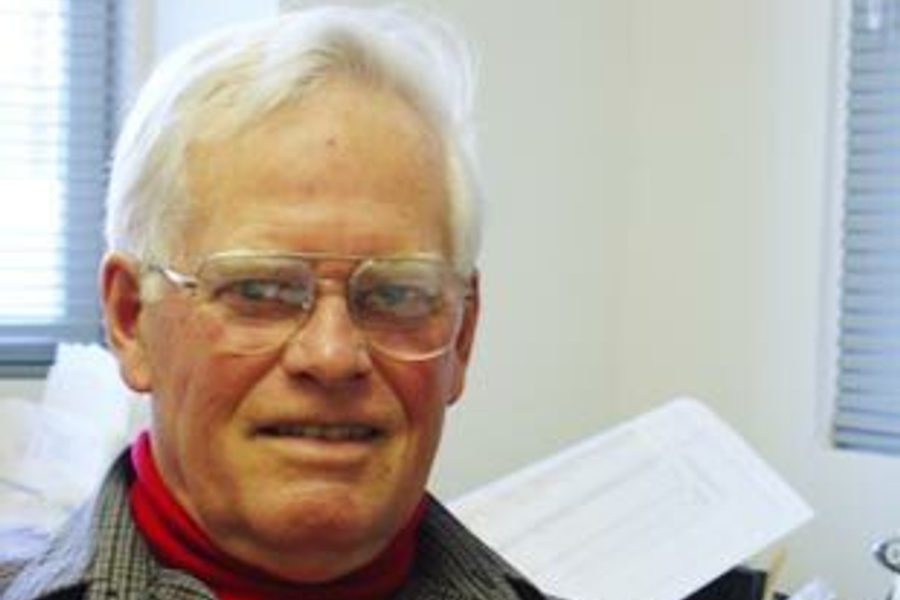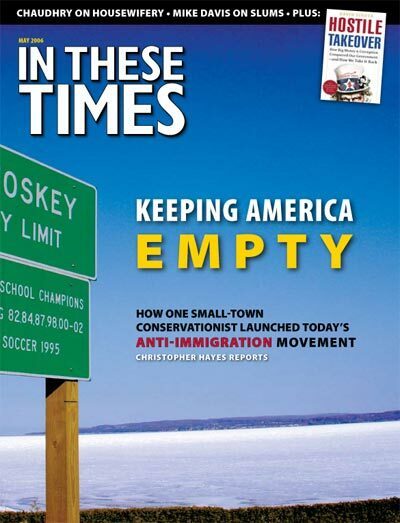Keeping America Empty
How one small-town conservationist launched today’s anti-immigration movement
Christopher Hayes

At the northern tip of Michigan’s lower peninsula lies the quaint town of Petoskey, population 6,080. In late March, a thick white shelf of ice still covers Lake Michigan, and a few miles north, over the Mackinac Bridge, the Upper Peninsula appears as a grey tangle of virgin wilderness. This isn’t the end of the world, residents say, but you can see it from here.
The town seems to have escaped much of the last four decades. Mom-and-pop stores and unassuming churches line its downtown, and there’s hardly a chain restaurant in sight. People wear flag pins on their lapels, even when they’re not running for office.
On the day I drive to Petoskey, the radio is buzzing with voices from the Great Immigration Debate: ranting talk show hosts, sermonizing senators and the chanting protests of thousands in Grand Rapids, a few hours south of Petoskey. Like hundreds of thousands of others, they are marching against House-passed legislation that would turn approximately 12 million undocumented immigrants into felons.
All the cacophony lacks is a mention of the one man who set much of this in motion 25 years ago, the man I had come to see: 72-year-old retired opthamologist John Tanton.
Tanton may not make headlines, but even a casual dusting of today’s anti-immigration movement reveals his fingerprints everywhere. Turn on Lou Dobbs and you’ll see experts from the Federation for American Immigration Reform (FAIR), the nation’s oldest and most influential immigration restriction group, which Tanton founded in 1979. Scan the newspapers and you’ll find Republican lawmakers reporting a tidal wave of calls from members of NumbersUSA, which Tanton cofounded. Watch the committee hearings on C-SPAN and you’ll hear anti-immigration talking points lifted straight from the Center for Immigration Studies, another Tanton creation. And on and on.
Thirty years ago, “if you wanted to call some group and say, ‘Tell me about immigration,’ there was no phone number,” recalls founding FAIR board member Otis Graham. Devin Burghart, who monitors the anti-immigration movement for the progressive Center for New Community, says that Tanton has done for immigration politics “what Pat Robertson did for the Christian Right. As a tactician, he’s done a brilliant job.”
Given that the movement he helped create now finds its base among conservative Republicans, you might expect John Tanton to be an unapologetic reactionary. You’d be wrong. He’s a self-described progressive, ex-Sierra Club member, Planned Parenthood supporter and harsh critic of neoclassical economists. So I wanted to know: How did a whip-smart, mild-mannered farm boy committed to conserving the natural world end up seeding and nurturing a movement that now dispatches gun-toting vigilantes to patrol the border?
— — — — — — — — — -
In person, Tanton hardly seems like a firebrand. He speaks softly, and carries himself with the reserved politeness of the small town doctor he was for 35 years. When I get to Petoskey at noon on a Monday, I find him in a Presbyterian church, where for the last 20 years his Great Books club has convened. Tanton briefly interrupts the discussion of Joseph Conrad’s Under Western Eyes to introduce me, casually mentioning the magazine I write for, where I went to school and even what my major was. For a 72-year-old man, he sure knows his way around Google.
Tanton and his wife Mary Lou moved to Petoskey in 1964 after he finished medical school. The town’s small clinic had an opening, and, particularly important, some of the most pristine wilderness in America was just minutes away. The couple quickly threw themselves into a variety of conservation causes.
A fundamental problem the nascent environmental movement identified was, in Tanton’s words, that “the economic system is based on continual growth forever,” which “in a finite world” isn’t possible. The Tantons and others in the movement became convinced that something would have to give, and that it shouldn’t be the planet. To avoid catastrophe, society would have to reconstitute itself to favor conservation over growth. It is a small-c conservative philosophy: What the cheerleaders of modernity called “progress,” they called a plague.
In 1968, a Stanford biologist named Paul Ehrlich made these ideas mainstream with his book, The Population Bomb. With terrifying certainty, Ehrlich argued that the exponential growth in population and the incremental growth in food could only mean one thing: mass famine. “The battle to feed all of humanity is over,” the book begins. “In the 1970s … hundreds of millions of people are going to starve to death.”
It was an instant sensation, turning “overpopulation” into a hot topic and landing Ehrlich repeatedly on “The Tonight Show.” Tanton had been ahead of the curve. As early as the ’50s, he avidly read reports from the Population Reference Bureau, and by the time Ehrlich’s book was published, he and Mary Lou had already started work on the first Northern Michigan chapter of Planned Parenthood. “I believed in the multiplication tables,” says Tanton. “Since I was a physician and could do something about birth control, it struck me that this was where I could make my contribution to the conservation movement.”
Time hasn’t been kind to Ehrlich’s predictions: Due to a technological revolution in agriculture, there was no mass famine. World population growth has slowed considerably; the United Nations now predicts it could plateau by 2050. Many, if not most, professional demographers today are more worried about depopulation in the developed world.
But in many quarters, this “fixed pie” view persists, and the logic isn’t necessarily flawed. Resources, particularly oil, are finite and the notion that technology will always be able to bail us out is dubious. Perhaps Ehrlich’s predictions weren’t wrong, just premature.
Tanton, whose worldview was forged in this intellectual milieu, is haunted by the spectre of an apocalypse just over the horizon, and the thought that he is one of a select few who see it coming. Sitting at his desk during one of our interviews, he reaches into a drawer, withdraws an electric metronome and flicks it on. As the device pulses at 135 beats per minute, he explains that each beat is a new birth (at the 1969 rate), and each new birth requires resources: food, clothing, education. It’s a trick he used when he gave talks on population in the ’70s, and it’s effective. His voice barely rises over the percussive onslaught, and after just 30 seconds you want to yell: “Make it stop!”
You get the sense that Tanton hears that beat inside his head all the time.
In 1969, Tanton started and chaired the population committee of his local Sierra Club chapter, and when Ehrlich and like-minded environmentalists founded the advocacy group Zero Population Growth (ZPG), he became one of its most active members, rising to its presidency in 1975. By then, the birthrate for Americans had declined below the replacement rate, but the American population was projected to keep growing. Tanton settled on the culprit: immigration.
The number of immigrants was still small by today’s standards but had started to creep upwards, thanks in part to a 1965 immigration bill that instituted family reunification policies and did away with 40 years of quotas that heavily favored northern Europeans. Since immigrants had higher birthrates, reducing their numbers would allow the United States to achieve the zero population growth that had seemed a pipe dream only a few years earlier.
Tanton pushed for the Sierra Club to take a strong stand to reduce immigration, but the organization balked. He didn’t have much more success with his fellow travelers at ZPG. Tanton chalks it up to fear of tackling a taboo subject, but it seems just as likely that they couldn’t see why it mattered on which side of the Rio Grande someone was born. Today, ZPG, since renamed Population Connection, takes what its current president, John Seager, calls a “global approach,” supporting female literacy, access to birth control and family-planning services in the developing world. If Tanton’s concern is the health of the planet, why doesn’t he subscribe to this view? He explains that reducing immigration will force countries like Mexico to confront their own population growth rates. “Each country,” he says, “ought to try to match its population to its resource base.”
Ultimately, Tanton realized it would be impossible to graft a new agenda onto an existing organization and resolved to found his own group. With Otis Graham and a couple of sympathetic board members poached from ZPG and several hundred thousand dollars in startup money from a wealthy Ehrlich devotee, Tanton founded FAIR on Jan. 2, 1979, with a mission to end illegal immigration and reduce legal immigration.
It was at this point that Tanton initiated the hyper-productive schedule he’d maintain for the next 29 years, spending Tuesday through Friday seeing patients at the clinic and working evenings, weekends and Mondays on immigration. While his physician’s life gave him the “ability to restore sight,” it was repetitive, he says. His activism was “abstract, focused on the long term and people called you bad names, but it was extremely stimulating.”
Tanton talks with such evident passion about the minutiae of organizing – the importance of correctly naming organizations, rules for recruiting effective board members – that it’s tempting to see his work on immigration as something like Oppenheimer’s work on the bomb, driven as much by the sheer intellectual challenge as by its ultimate goal. In an early memo to FAIR staffers, he explained his enjoyment of fundraising: “t’s the ultimate chess game, in three dimensions, with the players all able to move themselves.”
The Tantons spent a year in D.C. working for FAIR between 1981 and 1982 (“crowded” is John’s assessment of the city) and their enthusiasm was contagious. One FAIR staffer wrote that the organization had “all the excitement and energy of a gold rush town.” When he returned to Petoskey, Tanton continued to grow the movement, helping to found the Center for Immigration Studies, NumbersUSA, Immigration Reform Law Institute and a journal, the Social Contract Press, which he has published out of his office for 16 years. He had some successes: FAIR membership grew to 50,000 by 1990 (today it claims 198,000 “members and supporters”), and it successfully lobbied for increased border security and harsher penalties in the two rounds of immigration legislation passed in 1986 and 1996.
But by the late ’90s, the Republican Party, reluctant to alienate the growing Latino electorate and under pressure from its corporate backers, largely dropped immigration from its agenda. Meanwhile, the earlier crackdowns that FAIR had pushed for failed to stanch the flow of immigrants. As day laborers started appearing in formerly lily-white suburbs across the country, backlash politics began to gain momentum below the mainstream political radar.
The problem, from an organizing standpoint, was that FAIR wasn’t in a good position to take advantage of this. “FAIR is a big problem,” says Peter Brimelow, an anti-immigration activist who runs the Web site VDARE.com, “because its natural constituency is conservative nationalists, but its operatives are basically liberal and centrist and terrified by Pat Buchanan.” In fact, in the early days of the organization, the leadership was scared of its own members. The board resisted setting up local chapters for fear of who might show up and kept a tight lid on FAIR’s stationery, afraid some member would get their hands on it and write something “demagogic” that would discredit the group.
Tanton recognized this situation was untenable. Notes from a 1982 FAIR board meeting report that Tanton was “very concerned that FAIR has acquired only 4,000 real members in three years, and believes it is time to change our methods.” Crisscrossing the country, Tanton found little interest in his conservation-based arguments for reduced immigration, but kept hearing the same complaint. “‘I tell you what pisses me off,’” Tanton recalls people saying. “‘It’s going into a ballot box and finding a ballot in a language I can’t read.’ So it became clear that the language question had a lot more emotional power than the immigration question.”
Tanton tried to persuade FAIR to harness this “emotional power,” but the board declined. So in 1983, Tanton sent out a fundraising letter on behalf of a new group he created called U.S. English. Typically, Tanton says, direct mail garners a contribution from around 1 percent of recipients. “The very first mailing we ever did for U.S. English got almost a 10 percent return,” he says. “That’s unheard of.” John Tanton had discovered the power of the culture war.
The success of U.S. English taught Tanton a crucial lesson. If the immigration restriction movement was to succeed, it would have to be rooted in an emotional appeal to those who felt that their country, their language, their very identity was under assault. “Feelings,” Tanton says in a tone reminiscent of Spock sharing some hard-won insight on human behavior, “trump facts.”
More than anyone, Tanton served as the liaison between the “mainstream” anti-immigration movement, whose arguments were still rooted in population and job concerns, and its natural allies on the far right, who saw an epic struggle to maintain America’s national and racial character. He courted mainstream conservative donors, like the Scaife family, as well as the fringe Pioneer Fund, whose current president argues that blacks are genetically less intelligent than whites. He had the Social Contract Press translate, publish and promote The Camp of the Saints, a starkly racist apocalyptic novel about a wave of Indian immigrants overrunning France. In 1996, Tanton coauthored The Immigration Invasion with Wayne Lutton, who sits on the advisory board of a publication put out by the white nationalist Council of Conservative Citizens. Editor of the Social Contract Press since 1998, Lutton now occupies an office just a few feet from Tanton’s.
In 1985, Tanton began convening an annual retreat for the immigration restriction movement’s activists and writers, called WITAN, after Witenagemot, an Old English word for “wise council.” The gatherings draw everyone from labor economist Vernon Briggs, a self-described “liberal Democrat,” who worked on Texas union campaigns led by Caesar Chavez, to Jared Taylor, a white nationalist who publishes the journal American Renaissance. “Blacks and whites are different,” Taylor wrote in a recent article on Hurricane Katrina. “When blacks are left entirely to their own devices, Western Civilization – any kind of civilization – disappears.”
Taylor has attended the WITAN gatherings since their inception and says despite the divergent backgrounds of the participants, everyone is collegial out of respect for Tanton. “There’s a real leadership quality in a man who can bring together so many different points of view to work together towards a common goal.”
In a 1986 memo written to stimulate discussion at the upcoming retreat, Tanton mused on the effects of immigration on California, wondering if Latin American immigrants would “bring with them the tradition of the mordida (bribe)” and “the lack of involvement in public affairs.” Later he fretted that Latinos’ higher birth rates would lead to increased political power: “On the demographic question: perhaps this is the first instance in which those with their pants up are going to get caught by those with their pants down!”
Two years later, as U.S. English was campaigning for a referendum in Arizona, opponents leaked the memo to the press, prompting early supporters like Linda Chavez and Walter Cronkite to publicly sever their ties to the organization. The Southern Poverty Law Center reprinted the memo in a 2002 cover story in its magazine, documenting Tanton’s various connections to hard right proponents of extremist racial views.
Tanton calls the “pants down” section “a throwaway line I should have thrown away.” He bristles when I bring up the SPLC article, calling charges of racism a means of avoiding the real questions about immigrant quotas and policy enforcement. And he’s so practiced at responding to this criticism, he easily swats away my repeated attempts to pin him down: Does he think white America is imperiled by the growth of the Latino population? How does he feel about the views of the white nationalists with whom he has allied himself?
“What’s the definition of racism?” he snaps. “I have a different type of definition: taking race into account. They” – meaning groups like SPLC who criticize him– “are noticing it. They’re saying that race is important to them.”
Though he plays the victim, Tanton wants it both ways: harnessing the political power that comes from tapping into nativist grievances and building bridges with outright racists, while at the same time dismissing any of the negative consequences that might come from such partnerships. Perhaps Tanton shares the views of his allies, or perhaps he simply understands that if what people like Taylor euphemistically call “cultural” issues were taken out of the equation, there wouldn’t be the same flood of phone calls to senators. “If the 12 million illegal immigrants in this country were all good-looking, English-speaking, white people,” Taylor told me, “the opposition to illegal immigration would be considerably less.”
— — — — — — — — — -
After I return home, Tanton sends me a barrage of follow-up correspondences: a correction for the birthrate of India, which he’d misstated, a Paul Krugman column on immigration, and an article from a local conservation newsletter about the havoc an invasive fungus called the Phytopthora has wreaked on the American chestnut tree.
In our interviews, Tanton returned time and again to the threat invasive species pose for the American ecosystem. Reading his note, it occurred to me that what has tied together all of Tanton’s activism – from setting up local preserves, to reducing highway billboards, to his 25 years in the anti-immigration movement – is a fear of contamination, a desire for some idealized notion of purity, a landscape and nation undefiled.
The irony is that on the one issue where he’s directed the bulk of his effort, the means he’s chosen haven’t proved particularly effective. Thanks in large part to Tanton’s efforts, over the last two decades the number of hours border guards spend on patrol has increased eightfold and the border patrol’s budget has gone from $151 million in 1986 to $1.6 billion by 2002. It hasn’t worked.
The problem is that nowhere else in the world do two countries with such disparate relative wealth share such a massive border. The ultimate way to reduce immigration is, as one writer once put it, to fix the “the poverty, population and distribution of wealth” in the countries that people are leaving.
That was John Tanton in the ’70s, when he first started writing about immigration. Going through Tanton’s early writing, I was struck by how much emphasis he put on the brain drain problem that immigration caused for developing nations, and the need to address underlying inequality between countries. With a liberal like me sitting in front of him, Tanton cogently and persuasively recites these arguments.
But conservative talk radio hosts, and Lou Dobbs viewers, and Minutemen along the Arizona border aren’t focused right now on development, or reducing inequality. They want fences. They want enforcement. They want arrests.
So that’s what John Tanton wants, too.








